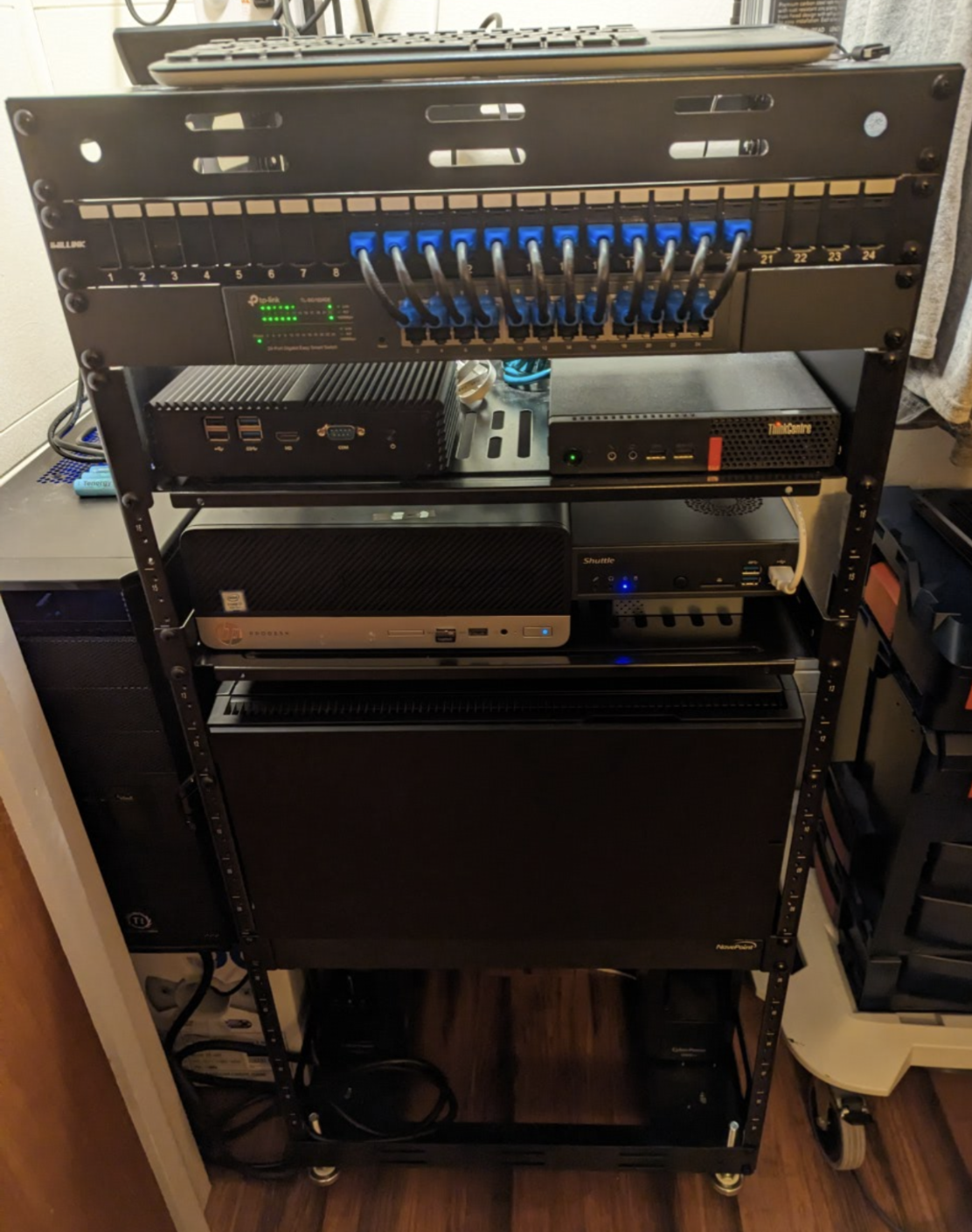That's a nice setup. I am weirdly jealous of the sliding shelf. The CS350B is very nice as well.
TrenchcoatFullofBats
Heat, then suction?
On a related note, I solved the battery issue with my wall mounted Fire tablet (for an HA dashboard) by connecting the power supply to a smart plug and setting up an automation to only give it the juice for about 3 hours per day, spread throughout the day
 From top to bottom:
From top to bottom:
- Patch panel (with artisinal, handmade cables)
- TP-Link managed switch Shelf 1:
- PFSense 4 port firewall
- Lenovo m910q w/Proxmox (cluster node 1) running 2 VMs for docker hosting: Ubuntu for media stuff (arrs, navidrome, jellyfin, calibre, calibre-web, tubesync, syncthing) and Debian for other stuff (paperless-ngx, vikunja, vscodium, redlib, x-pipe webtop, fasten health, linkwarden, alexandrite), 1 Win 10 VM for the very few times I need to use windows, some Red Hat Academy student and instructor RHEL 9 VMs, and an OPNsense VM for testing Shelf 2:
- HP Elitedesk G5 800 SFF w/Proxmox (cluster node 2) with an Nvidia GT 730 passed through to a Debian VM used primarily as a remote desktop via ThinLinc, but also runs a few docker containers (stirling pdf, willow application server, fileflows)
- Shuttle DH110 w/Proxmox (cluster node 3) with 1 VM running Home Assistant OS with an NVME Coral TPU passed through as well as a zooz 800 long range zwave coordinator (the zigbee coordinator is ethernet and in a different room) and two LXCs with grafana and prometheus courtesy of tteck (RIP) Shelf 3:
- WIP Fractal R5 server to replace the ancient Ubuntu file server to the left (outside the rack, sitting on the box of ethernet cable) that is primarily the home of my media drives (3 12 TB Ironwolf drives) and was my first homelab server. The new box will have a Tesla p4 and RX 580 GTX, i7-8700T and 64GB RAM in addition to the drives from the old server. I'll be converting the Ubuntu drive from the old server into an image and will use it to create a Proxmox VM on the new server, with the same drives passed through. Bottom:
- 2 Cyberpower CP1000 UPS with upgraded LiFePO4 batteries. The one on the left is only for servers and only exists to give the servers time to shut down cleanly when the power goes out. The one on the right is only for network devices (firewall, switch and the Ruckus R500 out of shot mounted higher in the closet)
The internet certainly forgets...but a Usenet service with good retention will remember for about a decade
I've moved to Garmin now, but I have an ocean's worth of salt over Pebble as well.
LET US LISTEN TO YOU IT WILL BE FINE.
IGNORE ME!
My solution to this problem is Jellyfin, fed by usenet-backed sonarr/radar and Tubesync to pull in YouTube channel subscriptions. Those are added to a Jellyfin library which is accessible right next to movies and tv shows.
This is all through the Jellyfin app on a 2019 Nvidia Shield Pro. It's a perfect couch-friendly setup. For just regular YouTube browsing, SmartTube can be installed on the Shield and on your phone. You can then cast to the SmartTube app on the Shield instead of to the YouTube app.
You may also want to look into Usenet instead of torrents when you're researching. Sonarr/Radarr/Readarr etc all work (in my opinion) better with Usenet.
You'll need to pay some, but the reliability is amazing, which is extremely helpful for the partner acceptance factor. I pay for two providers (newsdemon is primary and eweka is a backup) and two indexers (drunkenslug and nzbfinder), and everything has been rock solid reliable for years. Download speeds are also MUCH faster than torrents.
Combine this setup with overseerr (or jellyseerr) so your partner can find their own things to download and you might be able to get them back on board.
Plus, no flaresolverr required!

Yeah, the tablet runs Fully Kiosk and I tried the same thing with the battery percentage thing and ran into the same issue, so I just simplified and made the automation time-based.
The tablet also likes to freeze a few times a day, so I also created an automation that toggles the smart plug power whenever HA loses connection to the tablet for more than 5 seconds, then toggles back to the original state at the start of the automation, which corrects the problem. Until the next time. But hey! It was only $60, so it's fine.